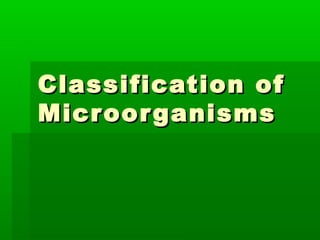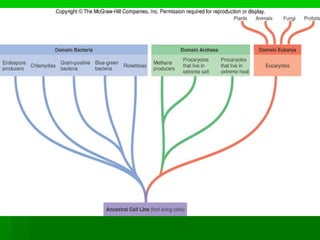3 classification of microorganisms
- 1. Classification of Micr oor ganisms
- 2. Taxonomy  Organizing, classifying and naming living things  Formal system originated by Carl von Linné (1701- 1778)  Identifying and classifying organisms according to specific criteria  Each organism placed into a classification system
- 3. Taxonomy  Domain  Kingdom  Phylum  Class  Order  Family  Genus  species
- 4. 3 Domains  Eubacteria  true bacteria, peptidoglycan  Archaea  odd bacteria that live in extreme environments, high salt, heat, etc. (usually called extremophiles)  Eukarya  have a nucleus & organelles (humans, animals, plants)
- 7. Taxonomy  4 main kingdoms:  Protista  Fungi  Plantae  Animalia  Algae
- 8. Naming Micoorganisms  Binomial (scientific) nomenclature  Gives each microbe 2 names:  Genus - noun, always capitalized  species - adjective, lowercase  Both italicized or underlined  Staphylococcus aureus (S. aureus)  Bacillus subtilis (B. subtilis)  Escherichia coli (E. coli)
- 9. Evolution - living things change gradually over millions of years  Changes favoring survival are retained and less beneficial changes are lost  All new species originate from preexisting species  Closely related organism have similar features because they evolved from common ancestral forms  Evolution usually progresses toward greater complexity
- 10. Insert figure 1.15 Woese-Fox System
- 11. Classification Systems in the Pr ocar yotae
- 12. Classification Systems in the Procaryotae 1. Microscopic morphology 2. Macroscopic morphology – colony appearance 3. Physiological / biochemical characteristics 4. Chemical analysis 5. Serological analysis 6. Genetic and molecular analysis • G + C base composition • DNA analysis using genetic probes • Nucleic acid sequencing and rRNA analysis
- 13. Bacterial Taxonomy Based on Bergey’s Manual  Bergey’s Manual of Determinative Bacteriology – five volume resource covering all known procaryotes  classification based on genetic information – phylogenetic  two domains: Archaea and Bacteria  five major subgroups with 25 different phyla
- 14. Major Taxonomic Groups of Bacteria  Vol 1A: Domain Archaea  primitive, adapted to extreme habitats and modes of nutrition  Vol 1B: Domain Bacteria  Vol 2-5:  Phylum Proteobacteria – Gram-negative cell walls  Phylum Firmicutes – mainly Gram-positive with low G + C content  Phylum Actinobacteria – Gram-positive with high G + C content
- 15. Diagnostic Scheme for Medical Use  Uses phenotypic qualities in identification  restricted to bacterial disease agents  divides based on cell wall structure, shape, arrangement, and physiological traits
- 16. Species and Subspecies  Species  collection of bacterial cells which share an overall similar pattern of traits in contrast to other bacteria whose pattern differs significantly  Strain or variety  culture derived from a single parent that differs in structure or metabolism from other cultures of that species (biovars, morphovars)  Type  subspecies that can show differences in antigenic makeup (serotype or serovar), susceptibility to bacterial viruses (phage type) and in pathogenicity (pathotype)
- 17. Archaea: The Other Procaryotes  Constitute third Domain Archaea  Seem more closely related to Domain Eukarya than to bacteria  Contain unique genetic sequences in their rRNA  Have unique membrane lipids and cell wall construction  Live in the most extreme habitats in nature, extremophiles  Adapted to heat, salt, acid pH, pressure and atmosphere  Includes: methane producers, hyperthermophiles, extreme halophiles, and sulfur reducers
- 18. Eukar yotes
- 19. Eukaryotes  Protista  Fungi  Plantae  Animalia  Algae
- 20. Fungal Classification  Sexual reproduction  Spores are formed following fusion of male and female strains and formation of sexual structure  Sexual spores and spore-forming structures are one basis for classification  Zygospores  Ascospores  Basidiospores
- 24. Fungal Classification  Subkingdom Amastigomycota  Terrestrial inhabitants including those of medical importance: 1. Zygomycota – zygospores; sporangiospores and some conidia 2. Ascomycota – ascospores; conidia 3. Basidiomycota – basidiospores; conidia 4. Deuteromycota – majority are yeasts and molds; no sexual spores known; conidia
- 25. Protozoan Classification  Difficult because of diversity  Simple grouping is based on method of motility, reproduction, and life cycle 1. Mastigophora – primarily flagellar motility, some flagellar and amoeboid; sexual reproduction; cyst and trophozoite 2. Sarcodina – primarily ameba; asexual by fission; most are free-living 3. Ciliophora – cilia; trophozoites and cysts; most are free-living, harmless 4. Apicomplexa – motility is absent except male gametes; sexual and asexual reproduction; complex life cycle – all parasitic



























